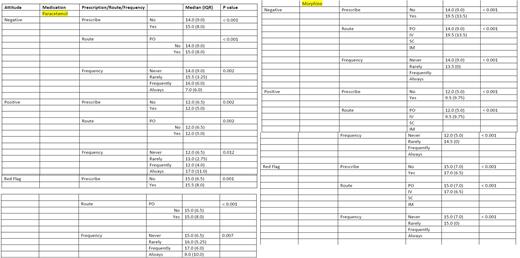Abstract
Introduction
Pain from vaso-occlusive crises (VOC) is the most common symptom experienced by patients with sickle cell disease (SCD). It is also the most common cause for emergency department (ED) visits and hospital admissions. Nevertheless, clinical studies of appropriateness of treatment provided during these episodes are sparse, and there are concerns that care for these patients is both inadequate and doesn't meet guidelines. Therefore, studies assessing the healthcare practitioners' knowledge and practice in pain management in SCD patients are an integral component in the process of improving the care provided to this vulnerable population.
The goal of our study is to assess adherence of physicians caring for SCD patients to the published guidelines in pain management (published by National Heart, Lung, and Blood Institute, and American Pain Society), and to identify risk factors for self-reported non-adherence. Thus this study should provide an opportunity for focused strategies to improve patients' care.
Moreover, this study is particularly important for The State of Qatar, as the burden of SCD in it is among the highest in the entire world.
Materials and Methods
This is a cross-sectional convenience sample survey study of physicians in Internal Medicine, Hematology and Emergency departments in two hospitals under Hamad Medical Corporation, the main health care provider in The State of Qatar. It is conducted using a validated written survey consisting of 34 items to assess provider attitudes and practices with SCD patients.
Excel program and SPSS version 29 were used for data analysis. Continuous data was analyzed descriptively using median (IQR). Mann Whitney test and Kruskal-Wallis test were used to compare average between groups at alpha level = 0.05).
Results:
We have 130 eligible participants with an 85% complete response rate (111 completed surveys). Most physicians self-report adherence to using parenteral opioids (81%) and acetaminophen (77.5%).
Self-reported adherence is lower for other recommendations including redosing opioids within 30 minutes if analgesia is inadequate (21%), use of patient-controlled analgesia (18%), sparing non-steroidal anti-inflammatory drugs (66%) and using hypotonic fluids for euvolemic patients (5%).
Factors that are associated with significant differences in analgesic practices in our study include age and race. For example, male physicians are more likely to use acetaminophen, and physicians who identified as "Others" under the category of race versus Whites, Blacks and Asians are more likely to administer morphine (P value = 0.015) during VOC. Other factors such as age, level of practice, and department are not associated with significant differences in analgesic practices.
Furthermore, analgesic practices are affected by physicians' attitudes.
Interestingly, high scores on both the positive and negative attitudes scales (thought to reflect opposing perceptions of individuals with SCD) are both associated with more frequent use of acetaminophen. Unexpectedly, and as shown in the table below, high scores on negative attitudes scale are associated with more frequent use of morphine, while high scores on positive attitudes scale are associated with less frequent use of it.
Discussion and conclusion
A large number of SCD patients will have at least one VOC annually. There's an association between the number and severity of these crises and mortality rate. Also, these crises affect patients' quality of life, economic contribution, and overall satisfaction.
The cornerstones of managing VOC are parenteral opioids and frequent reassessments. Our data show that the majority of surveyed physicians report that they adhere to guidelines about the use of opioids and acetaminophen for the treatment of VOC, while other recommendations have less penetration. Positive and negative attitudes toward SCD patients are not associated with lower adherence to guidelines.
Our data indicate that penetration of many of these recommendations into practice is poor. A policy statement from respective professional societies may help expert recommendations to penetrate the providers' practice. Furthermore, interventions to improve attitudes towards SCD patients should be undertaken, since these attitudes can exert some effects on patients' care.
Disclosures
No relevant conflicts of interest to declare.
Author notes
Asterisk with author names denotes non-ASH members.


This feature is available to Subscribers Only
Sign In or Create an Account Close Modal